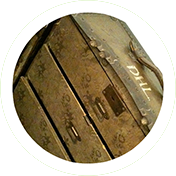Lawrence is never happier than when in the middle of the sea, between journeys, with the excitement and expectation of what lies ahead fuelling his enthusiasm.
Out on the sea, Lawrence has time to inform friends of ‘our great plunge![i]’ A little exaggeration is required, though, to convince him he’s made the right decision. Taormina, he informs Norman Douglas, ‘would have been the death of me after a little while longer[ii].’
Lawrence loves the liminal state of the sea, observing that ‘time passes like a sleep’ creating ‘the curious sense that nothing is real except just this ship[iii]’ This is because they are travelling along the 88 miles of the Suez Canal at five miles an hour. He occasionally spots black porpoises ‘that run about like frolicsome little black pigs[iv]’ which is a more pleasing image than the one reserved for Mount Sinai which is ‘like a vengeful dagger that was dipped in blood many years ago.[v]’
He stops off for a few hours in Port Said and observes it’s ‘still just like Arabian Nights, with water-sellers and scribes in the streets, and Koran readers and a yelling crowd[vi].’ His description of female Muslims in veils as ‘black women parcels’ would offend modern sensibilities, so take some comfort in that ‘one of the women drew back her veils and spat at us’ which he believes is because ‘we were hateful Christians.[vii]’
He remains optimistic ‘that once beyond the Red Sea one does not feel any more the tension and pressure one feels in England.[viii]’ But when he arrives in Kandy on 13 March, it is so hot that ‘if one moves one sweats.[ix]’ This leads him to worry ‘I don’t believe I shall ever work here[x]’ and before you know it, the familiar doubt kicks in: ‘I do think, still more now I am out here, that we make a mistake forsaking England and moving out into the periphery of life (…) I really think that the most living clue of life is in us Englishmen in England.[xi]’
To see other video essays from 1922 see our playlist here. To read from the original source, see The Cambridge Edition of The Letters of D.H. Lawrence, Vol IV 1921 – 24 edited by Warren Roberts, James T. Boulton and Elizabeth Mansfield.
References
- [i] Letter to Lady Cynthia Asquith, 28 Feb 1922 (L2467)
- [ii] Letter to Norman Douglas, 4 March 1922 (L2468)
- [iii] Letter to S.S. Koteliansky, 7 March 1922 (L2469)
- [iv] Letter Baroness Anna von Richthofen, 7 March (L2470)
- [v] Letter to S.S. Koteliansky, 7 March 1922 (L2469)
- [vi] ibid
- [vii] Letter Baroness Anna von Richthofen, 7 March (L2470)
- [viii] Letter to Rosalind Baynes, 8 March 1922 (L2472)
- [ix] Letter to Emily King, 24 March 1922 (L2476)
- [x] Letter to Catherine Carswell, 25 March 1922 (L2478)
- [xi] Letter to Robert Pratt Barlow, 30 March 1922 (L2480)
